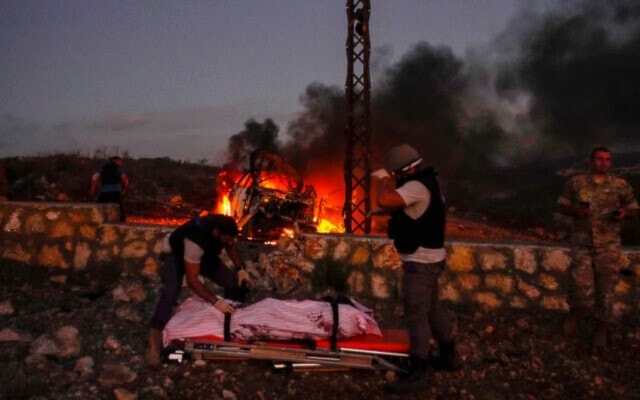'Israel' behind October strike on journalists in Lebanon: AFP probe
The available evidence suggests that the Israeli military had knowledge or should have had knowledge that the individuals they targeted with gunfire were civilians.
-

Civil Defense workers remove the body of Reuters videographer Issam Abdallah who was killed by an Israeli shelling, at Alma al-Shaab, south Lebanon, Friday, October 13, 2023. (AP)
Agence France-Presse, in collaboration with the NGO Airwars, conducted an investigation into the strike in southern Lebanon on October 13, resulting in the killing of a Reuters journalist and injuries to six others, including two from AFP.
The inquiry suggested that the attack involved a 120-mm tank shell exclusive to the Israeli army in the border region.
No other military group or organization in the region uses this type of munition, the analysts said.
The strikes are believed to have originated from the southeast near the Israeli settlement of "Jordeikh", where Israeli tanks were present.
The deliberate and targeted nature of the attack is inferred from the strikes' characteristics and the absence of military activity near the journalists. The investigation relied on evidence such as expert analysis of a munitions fragment, satellite imagery, witness accounts, and video recordings captured before and during the incident.
Tracing the impact of Israeli munition in Southern Lebanon
A group of seven journalists, including members from Reuters, Al-Jazeera, and AFP, experienced two successive strikes just after 18:00 on October 17 while documenting the brutal Israeli aggression on South Lebanon.
The first strike resulted in the immediate killing of Issam Abdallah, a 37-year-old Reuters photojournalist, while the remaining six journalists sustained injuries. Among them was AFP photographer Christina Assi, 28, who had to undergo a leg amputation and remains hospitalized.
Deliberate assault on journalists
A group of journalists documented Israeli bombardments in Lebanon from the summit of an exposed hill. All members were outfitted with helmets and "Press" marked bulletproof vests, and their cameras were prominently set up on tripods.
Several witnesses confirmed the absence of military activity or any indication of an armed group in their immediate surroundings in the hour leading up to the assault.
Experts deemed it unlikely that the Israeli army could have misidentified them as combatants, considering the advanced nature of its surveillance. Video footage revealed the presence of a low-flying helicopter and drone in the area before the attack.
The deliberate nature of the assault was underscored by the targeting of the journalists with two separate strikes, occurring 37 seconds apart and landing within a few meters of each other, eliminating the possibility of accidental firing, according to the experts.
Commenting on the incident, Human Rights Watch concluded that the strikes were "apparently deliberate attacks on civilians, which is a war crime" and which "should be prosecuted or may be prosecuted for war crimes." Amnesty, on its part, said the incident was "likely a direct attack on civilians that must be investigated as a war crime."
Not an isolated incident
The occupation forces have targeted numerous correspondents and journalists in both Gaza and Lebanon during the ongoing Israeli aggression on the two fronts.
In late November, an Israeli drone strike in southern Lebanon led to the martyrdom of Al Mayadeen's reporter Farah Omar and cameraman Rabih Me'mari, along with freelancer Hussein Akil.
#AlMayadeen's Chairman of the Board of Directors, Mr. Ghassan Ben Jeddou, announces a scholarship in the names of Farah and Rabih in their memorial service and reiterates Al Mayadeen's rejection to any media outlet's attempt to deal with the martyrs with contempt. pic.twitter.com/M9TAlTCLy7
— Al Mayadeen English (@MayadeenEnglish) November 28, 2023
Targeting journalists and civilians has become a standard within the doctrine of the Israeli occupation forces. The Palestinian Journalists Syndicate announced on December 1 that the number of media personnel and journalists martyred due to the Israeli aggression on the Gaza Strip since October 7 has risen to 67.

 3 Min Read
3 Min Read








